Occupational Environment Monitoring at Vacuum Cleaner Manufacturing Factory
99,000 ₫
Note: The above price is calculated for one sample, the price may vary depending on the area of the environment to be monitored and the fluctuations of the market. For more accurate price support, please refer to the quotation table or contact our consulting staff directly.
Environmental monitoring of the vacuum cleaner manufacturing factory is a session of collecting, analyzing, and evaluating workplace factors that may harm workers’ health.
Table of Contents
Toggle1. Overview of Vacuum Cleaner Manufacturing Factory
a. What is a vacuum cleaner manufacturing factory?
Factory of vacuum cleaners is a production facility specializing in manufacturing and assembling various types of vacuum cleaners. A vacuum cleaner is a device used to suction and remove dust, debris, grease, and other small particles from a specific surface or space. The vacuum cleaner manufacturing factory produces the components of vacuum cleaners, including compressors, motors, suction systems, and filters, and then assembles them into complete products.

b. Production stages in a vacuum cleaner manufacturing factory
During the production of vacuum cleaners, the factory may perform stages such as:
- Design and research: The factory conducts research and designs new models and technologies for vacuum cleaners, ensuring optimal performance and quality.
- Component fabrication: The factory manufactures and processes necessary components for vacuum cleaners such as dust containers, suction tubes, filters, motors, suction units, controls, and other parts.
- Assembly: After producing the components, the factory assembles them into complete vacuum cleaners, integrating components and establishing the control system.
- Inspection and certification: The factory inspects and certifies assembled vacuum cleaners to ensure they operate correctly and meet quality and safety standards.
- Packing and transportation: Once vacuum cleaners pass inspection and certification, they are packaged and prepared for shipment to distribution centers or end customers.

c. Machinery used in a vacuum cleaner manufacturing factory
In a vacuum cleaner manufacturing factory, several types of machinery are used for production and assembly stages. Some commonly used machines include:
- Metalworking machines: Machines such as cutting machines, bending machines, lathes, milling machines, and grinders are used to fabricate metal components like dust containers, suction tubes, and other parts of vacuum cleaners.
- Plastic molding machines: Plastic molding machines are used to shape and mold plastic components, such as vacuum cleaner casings, dust container lids, and other plastic parts.
- Tube cutting and bending machines: These machines are used to cut and bend suction tubes, creating suction elements and duct systems for vacuum cleaners.
- Wire cutting, welding, and processing machines: These are used to create electrical wiring and connections for vacuum cleaner components.
- Automated assembly machines: Automated assembly machines are used to assemble vacuum cleaner components automatically, increasing production efficiency while ensuring precision and uniformity.
- Quality inspection machines: These machines inspect assembled vacuum cleaners, including checking components, operational functionality, suction performance, and other quality standards.
- Printing and labeling machines: These machines print labels, tags, and other information onto vacuum cleaner components and products.

d. Occupational diseases that workers in vacuum cleaner manufacturing factories may face
In the working environment of a vacuum cleaner manufacturing factory, several occupational diseases may occur. Examples include:
- Respiratory diseases: Employees may be exposed to dust, metal fumes, chemical vapors, and other pollutants. Inhalation of these substances can cause pneumonia, asthma, sinusitis, and other respiratory issues.
- Skin diseases: Continuous exposure to chemical compounds, grease, and cleaning agents during vacuum cleaner production can cause skin issues such as dermatitis, itching, eczema, and irritation.
- Hearing problems: Production processes may generate noise, especially when machinery is operating. Prolonged and high-intensity noise can lead to ear toxicity and hearing loss.
- Musculoskeletal and spine diseases: Work involving lifting, moving, and transporting machinery and materials can stress the spine and muscles, causing injury or discomfort.
- Eye problems: Exposure to dust, chemical vapors, and other irritants can cause eye irritation, pain, and inflammation.
To prevent these occupational diseases, appropriate workplace safety and health measures should be implemented in the vacuum cleaner manufacturing factory. This includes dust, chemical, and noise control, adequate lighting, providing personal protective equipment, safety training, and compliance with occupational health and safety regulations.

e. Common types of vacuum cleaners on the market
There are many common types of vacuum cleaners on the market, including:
- Household vacuum cleaners: Used for cleaning homes and furniture. They are compact, with moderate power, and designed for easy use.
- Industrial vacuum cleaners: Powerful units used in industrial environments, factories, workshops, or construction sites. They can suction heavy dust and waste and have large capacities for collecting large amounts of dust.
- Wet/dry vacuum cleaners: Versatile units capable of suctioning both dry dust and liquids. They have separate filtration systems and containers for dust and water.
- Central industrial vacuum cleaners: Installed at a central location and connected via suction ducts to different points in a factory or building. They save space and effectively collect dust across the entire work area.
- Push-type industrial vacuum cleaners: These units have a push handle design for easy movement in narrow or hard-to-reach spaces, commonly used in workshops, construction sites, or other areas requiring mobility and flexibility.
2. Overview of Workplace Environmental Monitoring Services
a. What is workplace environmental monitoring at vacuum cleaner manufacturing factories?
Workplace environmental monitoring (or occupational environment assessment) at vacuum cleaner manufacturing factories involves collecting, evaluating, and analyzing measurement indicators of workplace environmental factors to implement timely measures, minimize environmental hazards to workers’ health, and prevent occupational diseases. Workplace environmental monitoring is mandatory for vacuum cleaner manufacturing factories.
It plays a crucial role in caring for, protecting, and enhancing worker health because the workforce is the main resource of a business and directly generates profit. Workers exposed to risk factors exceeding permissible limits are vulnerable to health issues and occupational diseases.
REGISTER FOR WORKPLACE ENVIRONMENT MONITORING SERVICE
b. Nam Viet’s workplace environmental monitoring program
Nam Viet’s workplace environmental monitoring program is developed by environmental monitoring engineers specializing in occupational safety and environmental protection. Aiming to ensure worker health and safety, the program uses modern measurement methods to monitor air quality, water, microclimate, physical, and dust factors in the workplace. This program is crucial for ensuring a safe working environment and protecting worker health.
Additionally, Nam Viet’s program plays an important role in researching and developing new solutions to improve workplace environmental quality. With the dedication and professionalism of its expert team, Nam Viet’s exclusive monitoring program is a breakthrough in occupational safety and environmental management in Vietnam.

c. Standardization in workplace environmental measurement procedures
Standardization in Nam Viet’s workplace environmental measurement procedures is essential to ensure accurate and reliable results. The program uses recognized standards and procedures from Ho Chi Minh City Department of Health, ensuring collected data is highly reliable for evaluating workplace environments and making decisions to improve conditions to protect workers’ health.
These standardized procedures also ensure that measurements are conducted by highly skilled monitoring specialists with years of experience, allowing managers and experts to trust results from An Toan Nam Viet and make accurate, valuable decisions in protecting workers’ health and the environment.
Applying standardized procedures demonstrates Nam Viet’s commitment to safe workplaces and worker health, while contributing positively to the development and improvement of occupational safety and environmental management in Vietnam.
d. Workplace environmental monitoring report for vacuum cleaner manufacturing factories
Workplace environmental monitoring results are prepared according to Form 04, Appendix III issued with Decree 44/2016/ND-CP and created in 2 copies: one for the workplace contracting the monitoring service, and one kept by the organization conducting the monitoring.
Monitoring results are kept indefinitely according to legal regulations.

e. Frequency of workplace environmental monitoring according to the law
According to Clause 2, Article 18, Labor Safety and Hygiene Law 84/2015/QH13, employers must conduct workplace environmental monitoring to evaluate harmful factors at least once a year.
f. Deadline for submitting workplace environmental monitoring reports according to the law
The deadline for submission is before December 31 each year. Enterprises at production facilities must submit monitoring reports to the local Department of Health where the business has its headquarters and where employees are working.
When there are changes in technology, production processes, or upgrades that may introduce new harmful factors to worker health, enterprises must update occupational hygiene records regarding the harmful factors that require workplace environmental monitoring.
g. Penalties for violations of workplace environmental monitoring by employers
According to Article 27, Decree No. 12/2022/ND-CP dated 17/01/2022 on administrative sanctions in labor, social insurance, and Vietnamese workers working abroad under contract:
- Clause 2: Fines from 2,000,000 – 5,000,000 VND for employers who do not publicly disclose monitoring results and hazard evaluations to employees immediately after obtaining them.
- Clause 3: Fines from 20,000,000 – 40,000,000 VND for employers who fail to conduct workplace environmental monitoring to control health risks to employees as required by law.
- Clause 4: Fines from 40,000,000 – 60,000,000 VND for employers colluding with monitoring organizations to commit fraud in monitoring activities but not to the level of criminal liability.
3. Harmful Environmental Factors for Workers in Vacuum Cleaner Manufacturing Plants
In vacuum cleaner manufacturing plants, there may be harmful environmental factors that can affect workers’ health. Below are some environmental factors that may pose risks in the workplace of a vacuum cleaner manufacturing plant:
- Dust: The vacuum cleaner production process can generate large amounts of dust. Dust may contain chemicals, debris, or fine particles that can damage workers’ respiratory systems and lungs.
- Chemicals: During vacuum cleaner production, chemicals such as solvents, organic compounds, and additives may be used. Prolonged or improper exposure to these substances can irritate the skin, eyes, and respiratory tract, and may lead to serious health issues.
- Noise: Machinery in vacuum cleaner manufacturing plants can produce high noise levels, especially during operation. Noise can cause stress, insomnia, reduced concentration, and long-term hearing damage for workers.
- Temperature and humidity: Some vacuum cleaner production processes may create work environments with high temperature and humidity. This environment can cause discomfort, fatigue, and negatively affect workers’ health and productivity.
- Other physical factors: Other physical factors such as bright lighting, vibrations, and additional physical impacts can also affect the health and safety of workers in vacuum cleaner manufacturing plants.
REGISTER FOR OCCUPATIONAL ENVIRONMENT MONITORING SERVICE
4. Measures to Improve the Working Environment in Vacuum Cleaner Manufacturing Plants
To improve the working environment in vacuum cleaner manufacturing plants and protect workers’ health, the following measures can be applied:
- Ventilation system: Install an effective ventilation system to remove dust and chemical vapors from the production process. The ventilation system should be designed and maintained regularly to ensure cleanliness and compliance with safety and health regulations.
- Personal protective equipment: Provide adequate and appropriate personal protective equipment such as masks, safety goggles, gloves, protective clothing, and safety shoes to prevent direct contact with dust, chemicals, and other environmental hazards.
- Training and education: Ensure that workers are trained in occupational safety, proper use of protective equipment, and safe working procedures in vacuum cleaner production environments. Increase awareness of health risks related to dust and chemicals.
- Dust control: Install efficient dust extraction systems and maintain regular industrial cleaning to minimize airborne dust. Clean work areas and equipment to prevent dust accumulation.
- Noise reduction: Implement measures to reduce noise at the source, such as using soundproofing materials, maintaining and adjusting machinery to lower noise, providing hearing protection for workers, and training them on noise-related health impacts.
- Chemical management: Use safe chemicals and replace hazardous substances with non-harmful alternatives when possible. Ensure proper work procedures, safe chemical storage, and staff training on safe handling and usage of chemicals.
- Periodically organize occupational environment monitoring in factories, collect and analyze harmful factors for workers, and adjust to reduce risks to prevent occupational diseases.
5. Benefits of Periodic Monitoring in Vacuum Cleaner Manufacturing Plants
An Toan Nam Viet provides enterprises with excellent benefits when using occupational environment monitoring services in compliance with Decree 44/2016/ND-CP on the management and control of harmful factors in the working environment affecting workers.
- Enterprises can actively control harmful factors in workshops or factories.
- Receive consulting and recommendations to minimize harmful factors and improve working environment quality.
- Indirectly protect human resources, a key factor in business development.
- Reduce the negative impact of occupational diseases on health, thereby minimizing future treatment costs.
- Improve workers’ health, which ensures product quality and maintains productivity.
- Comply with occupational safety laws, avoiding legal risks.
- Enhance credibility and professionalism, thereby elevating the enterprise’s brand.
Nam Viet’s environmental monitoring service is a solution to minimize occupational disease risks, contributing to a healthy and high-quality working environment.

6. National Occupational Environment Monitoring Center
Occupational Environment Monitoring Center of Nam Viet is a professional unit specializing in monitoring and measuring the quality of occupational environments nationwide across all provinces in Vietnam. With a team of experienced monitoring specialists, the center uses modern measuring equipment, ensuring accuracy and reliability.
In addition to providing monitoring services, the center assists clients with planning, handling, and tracking occupational environment issues. With the motto “customers are the center,” the center prioritizes client satisfaction, meets all client needs, and is committed to delivering the best solutions for businesses.
REGISTER FOR OCCUPATIONAL ENVIRONMENT MONITORING SERVICE
With investments in technology, equipment, and personnel, Nam Viet’s monitoring center has become one of the most reputable units in occupational environment monitoring in Ho Chi Minh City, with the following objectives:
- We highly value our brand reputation and service quality.
- We provide clients with the best and most suitable solutions.
- Alongside experienced Masters and Engineers, we aim to protect the environment and benefit enterprises.
- By partnering with Nam Viet’s Monitoring Team, companies receive professional service from experts and the best cost advantages.
The occupational environment monitoring process at Nam Viet includes the following steps:
- Before conducting monitoring, we ensure all equipment is calibrated and adjusted according to legal regulations.
- Carry out the monitoring process fully and correctly as committed to the Department of Health.
- Report monitoring results honestly to employers.
- If monitoring results indicate unsafe conditions for workers, Nam Viet will provide corrective solutions, and the workplace will implement the following:
- Implement measures to improve working conditions to minimize harmful factors and prevent occupational diseases.
- Organize health checkups to detect early occupational and work-related diseases for employees in unsafe environments.
- Provide workers with in-kind benefits according to labor law regulations.

7. Occupational Environment Monitoring Service Price Quotation
To help enterprises carry out occupational environment monitoring professionally and effectively, Nam Viet provides clients with a detailed price quotation for occupational environment monitoring services with quality and reasonable costs.
- Our quotation provides detailed information about the prices of monitoring services offered, including costs for transportation, measurement, analysis, and reporting. Clients can trust the accuracy and reliability of our monitoring reports.
- We are committed to offering competitive and reasonable prices and are always ready to provide fast and professional consultation regarding monitoring services.
- With Nam Viet’s quotation, clients can easily select service packages suitable for their needs. We are committed to delivering the highest satisfaction with professional service quality.
No comments yet

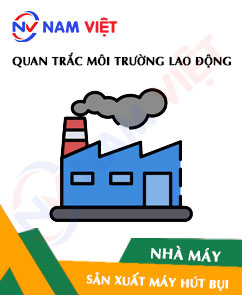
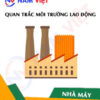
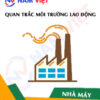


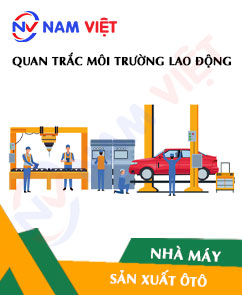
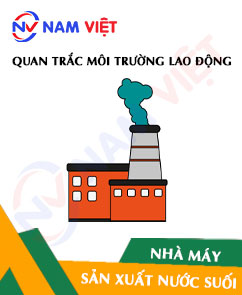
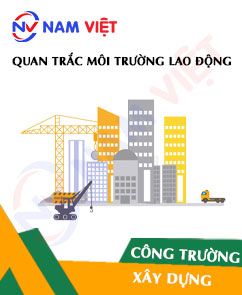

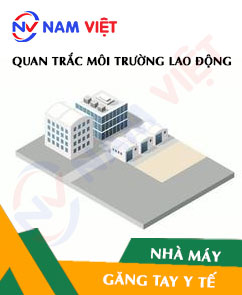

Review Occupational Environment Monitoring at Vacuum Cleaner Manufacturing Factory
There are no reviews yet.